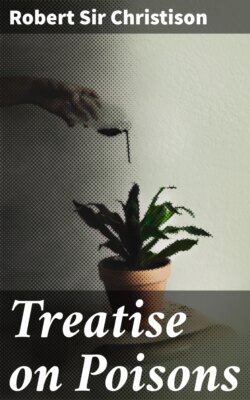Читать книгу Treatise on Poisons - Robert Sir Christison - Страница 23
На сайте Литреса книга снята с продажи.
CHAPTER III.
OF POISONING WITH THE MINERAL ACIDS.
ОглавлениеTable of Contents
Of the mineral acids, the most important, because the most common, are sulphuric, hydrochloric, and nitric acids. They are remarkably similar in their effects on the animal economy. Phosphoric acid is of much less consequence, and will be noticed cursorily.
Sulphuric acid (vitriolic acid, vitriol—oil of vitriol), hydrochloric acid (muriatic acid,—spirit of salt) and nitric acid (aqua-fortis), have been long known to be possessed of very energetic properties; and consequently cases of poisoning with them have often been observed. The instances of the kind hitherto published have been chiefly the result of suicide; a considerable number have originated in accident; and, however extraordinary it may appear, a few have been cases of murder. Tartra, in an excellent memoir on the subject of poisoning with nitric acid, quotes an instance of a woman having been poisoned while in a state of intoxication by that acid being mixed with wine and poured down her throat.[224] Valentini has related the case of a woman who was killed by frequent doses of sulphuric acid given under the pretence of administering medicines.[225] In 1829 an hospital servant was condemned at Strasbourg for trying to murder his wife in like manner, by first making her ill with tartar-emetic and then giving her sulphuric acid in syrup, under the pretence of curing her.[226] At the Aberdeen autumn circuit in 1830 a woman Humphrey was convicted of murdering her husband by pouring the same acid down his throat while he lay asleep with his mouth open.[227] On the whole, considering the powerful taste and excessively acrid properties of these poisons, it is probable that they will seldom be resorted to for the purpose of making away with another person, who is an adult, and in a state of consciousness. Of late, however, there have been several instances in our country of murder committed on infants in this barbarous manner. A woman Malcolm was executed here in 1808 for murdering her own child, an infant of eighteen months, by pouring sulphuric acid down its throat;[228] another woman Clark was tried for the same crime at Exeter in 1822; a man was executed lately at Manchester for murdering in the same way his son, a child four years and a half old;[229] and the particulars of an interesting trial will be presently noticed, that of Overfield, who was executed at Shrewsbury in 1824, for poisoning his child in the like manner.[230]
In a medico-legal point of view, the mineral acids are interesting on another account. Of late a new crime has arisen in Britain, the disfiguring of the countenance by squirting oil of vitriol on it. It originated in Glasgow, during the quarrels in 1820, between masters and workmen regarding the rate of wages,[231] and became at last so frequent, that the Lord Advocate, in applying for an act of Parliament to extend the English Stabbing and Maiming act to Scotland, added a clause which renders the offence now alluded to capital. In 1828 a woman Macmillan was tried here and condemned under that act.[232] The crime afterwards became common in England. Three cases were noticed in the newspapers as having occurred in London, in November, 1828; and two others near Manchester in the spring of 1829. It is now much less frequent.
The mineral acids are also very interesting on scientific grounds. They afford the purest examples of true corrosive poisons, their poisonous effects depending entirely on the organic injury they occasion in the textures to which they are applied. It is of use to set out, in investigating the effects of poisons, by determining the phenomena presented under such circumstances. When made aware of the rapidity with which other irritating poisons prove fatal, and the slight signs they commonly leave of their operation, one cannot fail to be struck with discovering what the animal frame will sometimes endure from these the most violent of all irritants, and nevertheless recover.
In laying down the mode of determining by chemical evidence a case of supposed poisoning with any of the three mineral acids mentioned above, it will be unnecessary to notice any of their chemical properties, except those from which their medico-legal tests are derived.
The only common properties that require notice are, their power of reddening the vegetable blue colours, for showing which litmus-paper is commonly used, and is most convenient: and their power of staining and corroding all articles of dress, especially such as are made of wool, hair, and leather. This last property is specified, though a familiar one, because it always forms important evidence in criminal cases. In order to give precision to such evidence, it is necessary to remember, that if the article of dress is a coloured one, it is generally rendered red by the mineral acids; but that the vegetable acids also will redden most articles of dress, although they do not corrode them.
